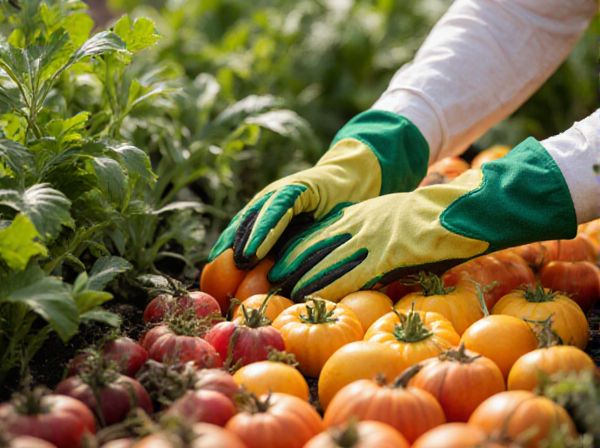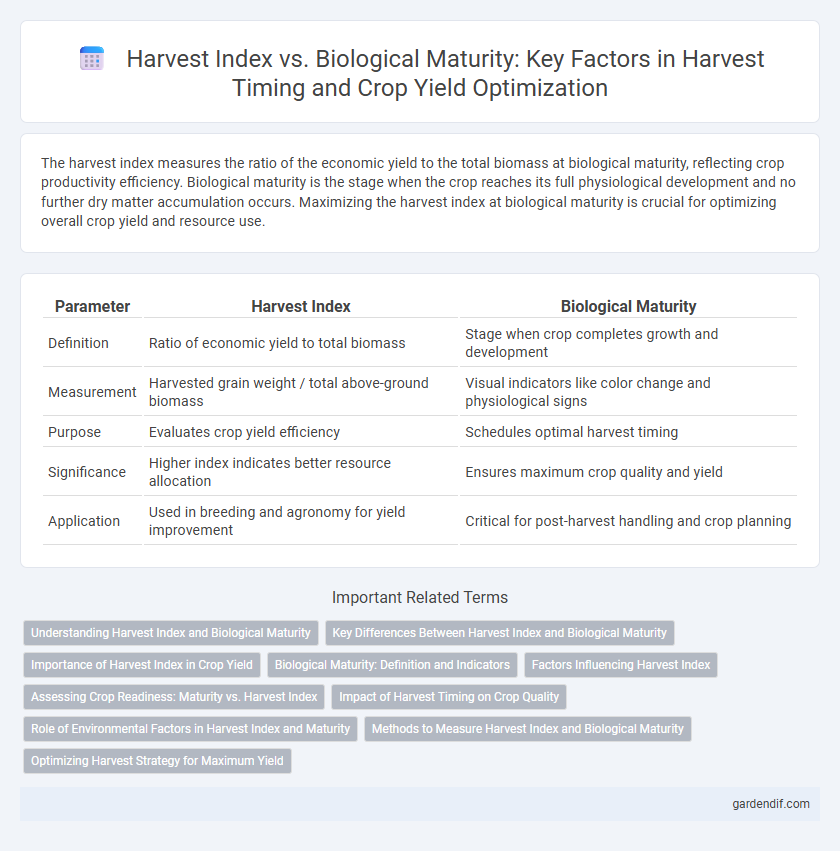
Harvest index vs biological maturity Illustration
The harvest index measures the ratio of the economic yield to the total biomass at biological maturity, reflecting crop productivity efficiency. Biological maturity is the stage when the crop reaches its full physiological development and no further dry matter accumulation occurs. Maximizing the harvest index at biological maturity is crucial for optimizing overall crop yield and resource use.
Table of Comparison
| Parameter | Harvest Index | Biological Maturity |
|---|---|---|
| Definition | Ratio of economic yield to total biomass | Stage when crop completes growth and development |
| Measurement | Harvested grain weight / total above-ground biomass | Visual indicators like color change and physiological signs |
| Purpose | Evaluates crop yield efficiency | Schedules optimal harvest timing |
| Significance | Higher index indicates better resource allocation | Ensures maximum crop quality and yield |
| Application | Used in breeding and agronomy for yield improvement | Critical for post-harvest handling and crop planning |
Understanding Harvest Index and Biological Maturity
Harvest index reflects the ratio of economic yield to total biomass at biological maturity, providing insight into crop productivity efficiency. Biological maturity marks the stage when maximum dry matter accumulation is reached, signaling completion of the plant's growth cycle. Understanding the interaction between harvest index and biological maturity aids in optimizing harvest timing for improved yield quality and quantity.
Key Differences Between Harvest Index and Biological Maturity
Harvest index measures the ratio of economic yield to total biomass at harvest, reflecting crop efficiency in converting biomass into harvestable product. Biological maturity indicates the stage when a crop completes its physiological development and stops growth, signaling readiness for harvest. These concepts differ as harvest index quantifies yield efficiency, whereas biological maturity signifies the timing of crop readiness.
Importance of Harvest Index in Crop Yield
Harvest index, defined as the ratio of economic yield to total aboveground biomass at biological maturity, serves as a critical indicator of crop productivity efficiency. A higher harvest index signifies a greater proportion of biomass allocated to harvestable yield, directly impacting total crop output and economic returns. Monitoring and optimizing harvest index during biological maturity stages empowers breeders and farmers to enhance crop yield potential under varying environmental conditions.
Biological Maturity: Definition and Indicators
Biological maturity refers to the stage when a crop reaches its maximum dry weight, indicating full development of grains or fruits. Key indicators include the cessation of growth in the vegetative parts, color changes in the plant, and moisture content levels dropping to a critical threshold. This stage is crucial for accurate harvest index calculation, which measures the ratio of usable yield to total biomass.
Factors Influencing Harvest Index
Factors influencing harvest index include genetic traits, environmental conditions, and crop management practices. Nutrient availability, particularly nitrogen, and water stress during critical growth stages significantly affect the partitioning of biomass to the harvested organs, impacting the harvest index. Optimizing planting density and timing can improve biomass allocation efficiency before biological maturity, enhancing overall crop yield.
Assessing Crop Readiness: Maturity vs. Harvest Index
Harvest index quantifies the ratio of usable crop yield to total biomass, serving as a critical indicator when assessing crop readiness for harvest. Biological maturity reflects the physiological stage at which a crop ceases growth and begins natural senescence, often preceding optimal harvest index values. Evaluating both maturity and harvest index enables precise timing to maximize yield quality and overall harvest efficiency.
Impact of Harvest Timing on Crop Quality
Harvest timing significantly influences the harvest index, which measures the ratio of economic yield to total biomass at biological maturity. Delayed harvesting may increase total biomass but often reduces the harvest index due to the decline in grain quality and moisture content. Optimizing harvest timing ensures maximum crop quality by balancing yield quantity and physiological maturity.
Role of Environmental Factors in Harvest Index and Maturity
Environmental factors such as temperature, soil moisture, and nutrient availability significantly influence the harvest index by affecting the distribution of biomass between grain yield and vegetative parts during biological maturity. High temperatures and drought stress often reduce the harvest index by accelerating maturity and limiting photosynthate allocation to grain filling. Optimal environmental conditions extend the grain-filling period, enhancing harvest index and improving the overall crop yield at biological maturity.
Methods to Measure Harvest Index and Biological Maturity
Harvest index measurement relies on accurately dividing total grain yield by the above-ground biomass at biological maturity, often using destructive sampling methods to collect representative plant samples. Biological maturity is determined by monitoring physiological markers such as leaf senescence, dry matter accumulation, and moisture content decline, employing tools like moisture meters and visual phenological scales. Combining biometric measurements with remote sensing technologies enhances precision in assessing both harvest index and biological maturity under varying agronomic conditions.
Optimizing Harvest Strategy for Maximum Yield
Harvest index, defined as the ratio of grain yield to total above-ground biomass, peaks near biological maturity, signaling optimal timing for harvest to maximize yield efficiency. Monitoring physiological indicators such as chlorophyll content and dry matter accumulation enables precise alignment of harvest operations with the crop's developmental stage. Adjusting harvest schedules based on these parameters improves resource use, reduces losses, and enhances overall productivity.
Harvest index vs biological maturity Infographic

 gardendif.com
gardendif.com